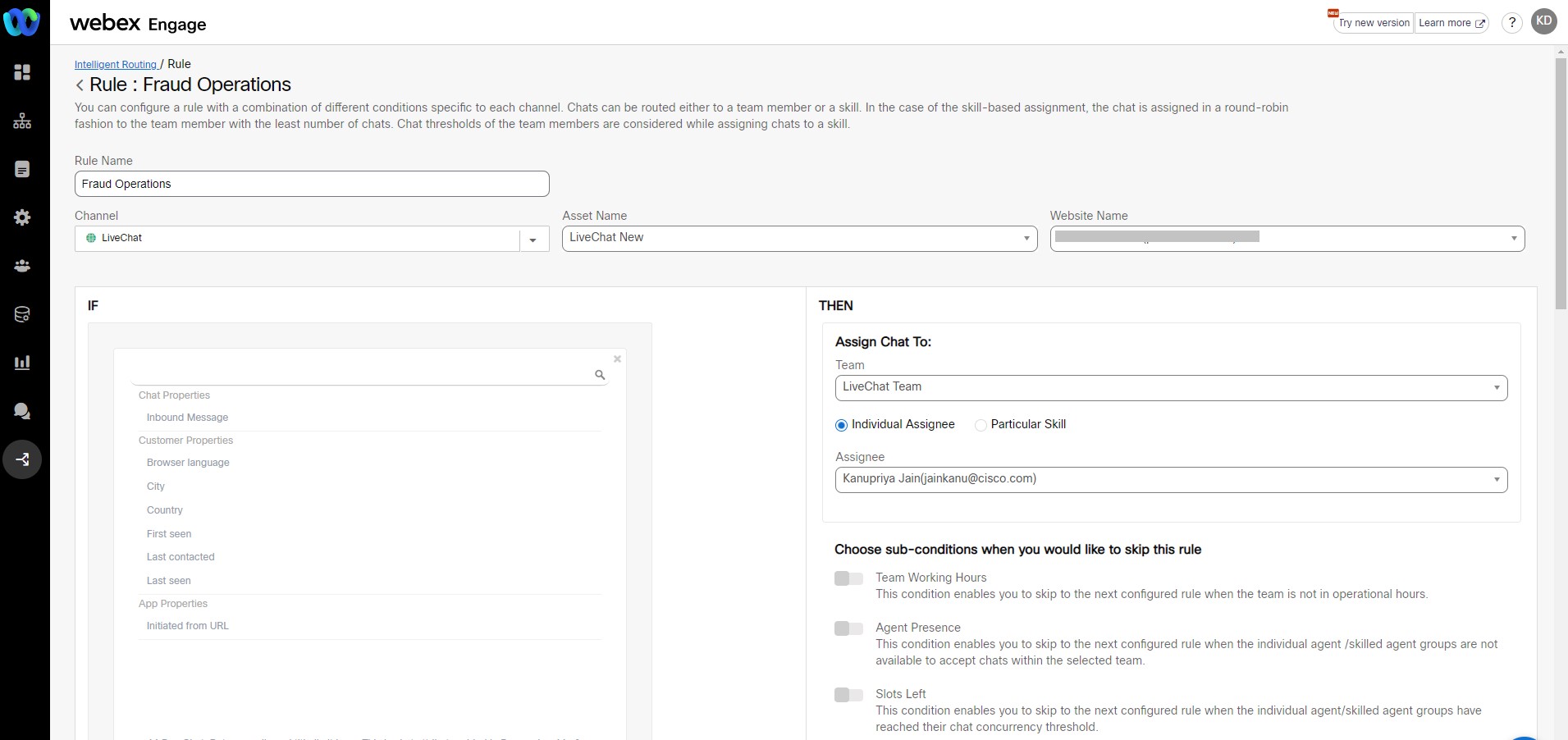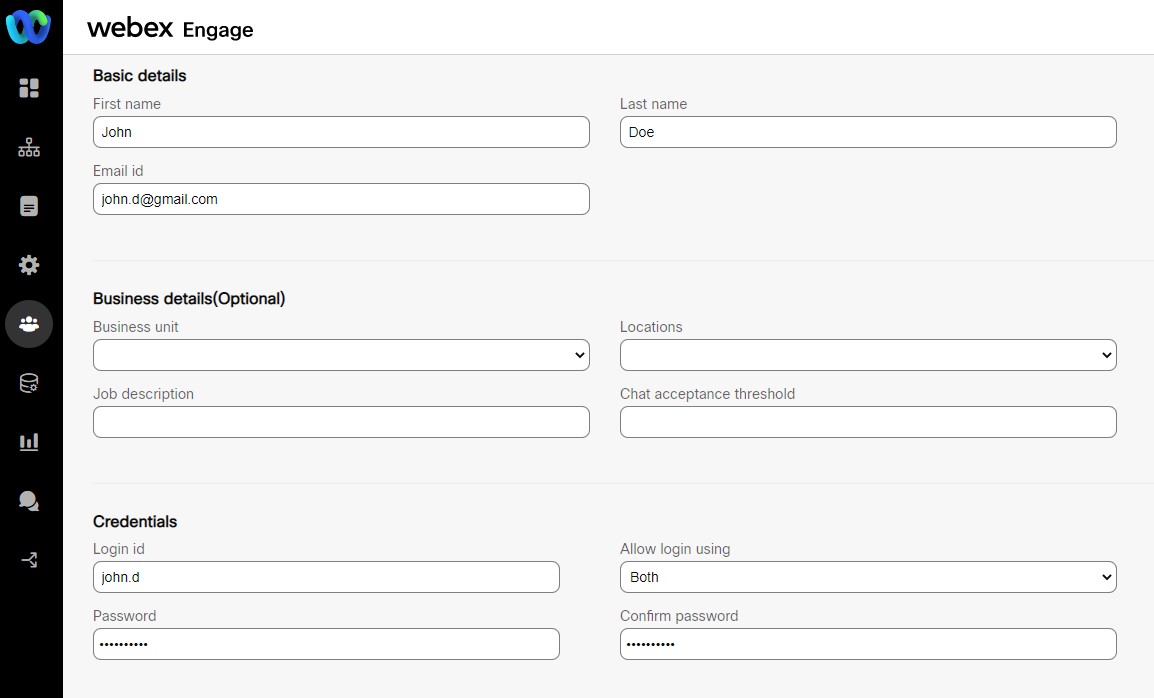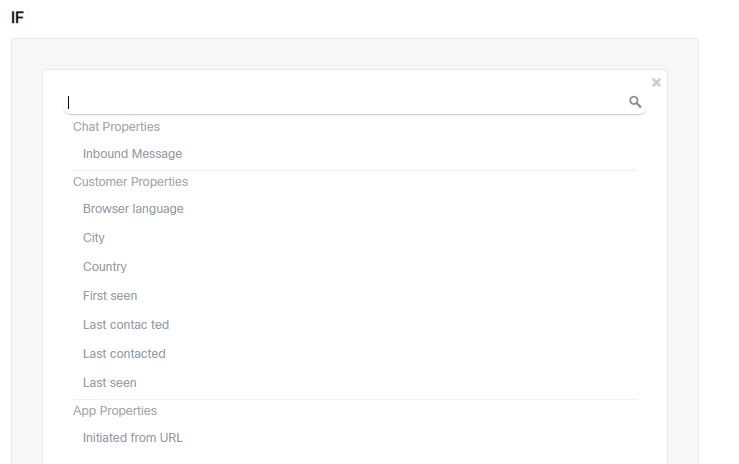Intelligent Routing
Webex Engage's Intelligent Routing feature provides a provision to the client admins to define rules and auto assign chats to agents based on these pre-configured rules. The rules can be configured based on customer attributes, inbound messages, chat attributes and pre-chat survey fields in the Livechat widget. You can either assign a chat to a skill or an individual agent.
Webex Engage's intelligent routing feature is supported on SMS, Email, Facebook, Twitter, API, and LiveChat channels. These rules are applicable for new chats alone. The first inbound message of a chat gets picked while processing the routing rules.
To route chats on channels (WhatsApp and Apple Business Chat) that do not support intelligent routing to a skill, you can use a parameter called Chat Creation Time. Using this parameter client admins can configure rules for chats created in a specified time interval. This feature can also be used to assign chats to specific teams/skills based on the contact center's operational shift timings. This parameter is even applicable to chats created via API.
Skill-based Routing
To enable skill-based routing on Webex Engage, agents should be grouped into logical skills based on their attributes. The client admins can pre-configure attributes.
Define Routing Attributes
The client admins can define routing attributes that can be assigned to the user(agent) profiles.
Follow these steps to configure routing attributes:
- Go to Settings > Routing Attributes.
- Click Add an Attribute on the top-right corner of the page.
- Add an attribute by providing a Name, Type, and Description.
The client admin can create any number of attributes within a tenant.
Assign Custom Attributes to Agent Profiles
Follow these steps to assign a custom attribute to an agent profile :
- Log in as client admin and go to the Users section.
- Add a user profile or edit an existing user profile to view the profile details page.
- Under the Custom Attributes section, add a custom attribute .
- Choose a Key from the list of pre-defined custom attributes and provide a Value.
Add Skill
The skills help to logically group users (agents) based on attributes that they possess. Skills can be configured at Team Level.
Follow these steps to add a skill:
- Go to Client Admin Console > Groups and select a team within a group.
- Under the Skills tab, click Add Skill.
- Enter Name and Description.
- In the rule builder, create a skill using a combination of custom attributes.
Add Rule
Once the skills are created, rules can be created using a combination of various customer and chat attributes. The rules will be triggered when a new chat is created. Based on the conditions configured within the rules, any chat fulfilling the conditions will be assigned either to a skill or an live / virtual agent.
Follow the below steps to add a new rule:
- Click Add Rule on the top-right-corner of the intelligent routing page.
The following screen appears.

- Enter Rule Name.
- Select the Channel, Asset, and Website from the respective drop-down lists.
- Build a rule by using a combination of conditions on customer properties and chat properties.
- Define the chat assignment condition.
'Assign to Particular Skill' will assign the chat to any of the agents who match a particular skill. This happens in a round robin fashion giving priority to the agents with the least number of chats.
'Assign to Individual Assignee' will assign the chat to the selected user.
Note:
In case a chat matches the conditions of a rule but none of the agents are available to accept chats (because of a limit on the threshold), the chat will be assigned to the team's queue.
- If you select individual assignee radio button, the Assignee drop-down list appears. This option lists all the available live and virtual agents.

- Client admins can skip a routing rule instead of queuing the chat within the same skill, based on the following conditions thereby allowing businesses to offer lower wait times.
Team Working Hours: When this condition is enabled, the system checks the condition first and skips the rule if the team is not in working hours and checks the consecutive rules defined for that team.
Agent Presence: When this condition is enabled, the system checks the condition first and skips the rule if the individual agent or skilled agents are not available to accept chats within the selected team.
Slots Left: When this condition is enabled, the system checks the condition first and skips the rule if the individual agent or skilled agent groups have reached their chat concurrency threshold.
If all the conditions are enabled, the system will skip the rule based on the above sub-conditions else, it will execute other configured rules.
- Enable the required sub-conditions.
- Click Save and Close, to save the rule.
- Click Save and Publish, to publish the rule.
The success message appears on the screen.
If you assign chats to a skill (while adding/editing an IR rule) that have no users under them, Webex Engage displays a warning message.
Edit Rule
Follow these steps to edit a rule:
- Click Edit icon in the actions column of the IR rules screen.
The following screen appears.

- Edit the required fields.
- When you edit a skill, Webex Engage throws an error message with the list of routing rules that might get affected while editing it.
- Click Save or Close.
- Click Save and Close, to save the rule.
- Click Save and Publish, to publish the rule.
The success message appears on the screen.
Content-based Routing
Client admins can configure routing rules based on the presence of certain keywords or phrases within an incoming message. This can be achieved using inbound message attribute under chat attributes on all channel except email channel.

Content-based routing rule can be configured using Equal to or Contains operator on one or more keywords or phrases.
For email as a channel, this feature is applicable only on the subject line but not on the body.
Note:
A maximum of 50 characters are allowed for keywords/phrases in these rules. If you have a use case that requires more characters, multiple rules can be chained using the AND or OR constructs.
Trailing spaces are ignored if present in the configured phrase.
A minimum of Three characters must be given when using the contains operator.
When using the contains operator, spaces between multiple words in a phrase are ignored when checking at runtime.
For example, if you want to check whether a message contains the phrase debit card, the rule will be activated for both the messages I have an issue with my debit card and I want a new debit card.
Updated over 3 years ago
